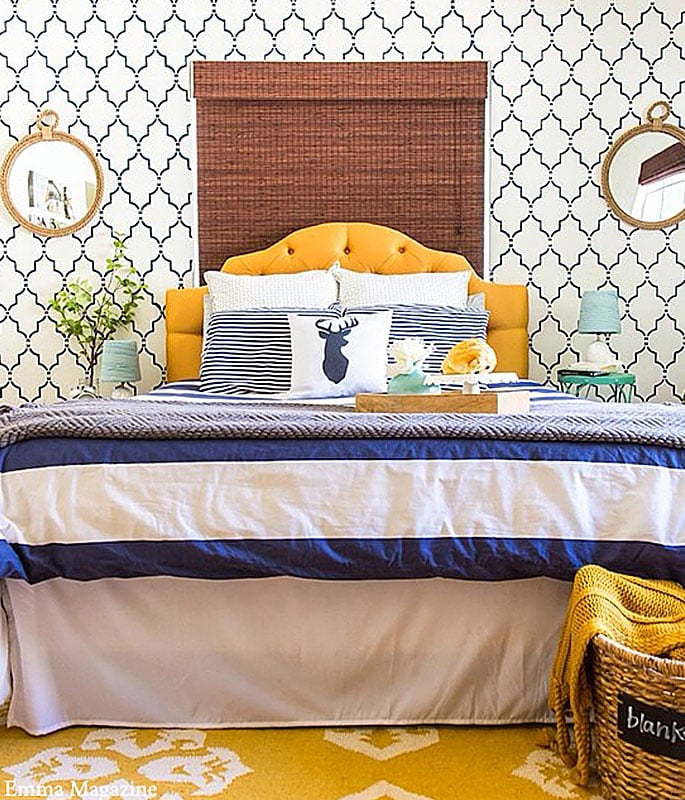
ALLOVER WALL STENCILS
Allover Wall Stenciling: How To Stencil A Wall To Get A Wallpaper Look
Stenciling is easy when you follow a few basic guidelines!
If you properly prepare the surface to be stenciled and use the proper tools and techniques, your stenciling project should be a fun and rewarding experience. Not to mention how much money you can save with DIY decorating. Any mistakes are easily correctible so let’s go and stencil something!
What You’ll Need
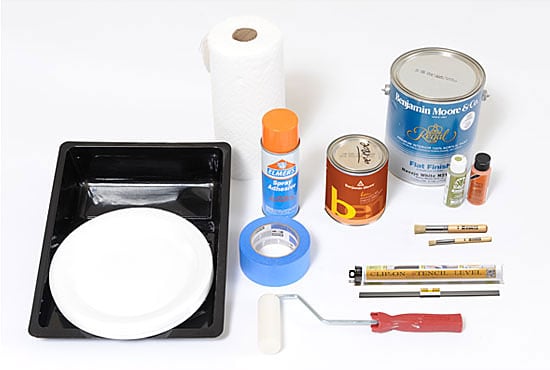
- Your Cutting Edge Stencil
- Stencil Paint (latex or acrylics)
- Base Coat Paint (for touch-ups)
- Low Tack Painters Tape
- Stencil Brush
- Dense Foam Roller
- Paint Tray or Paper Plate
- Paper Towels
- Spray Adhesive (optional)
- Cutting Edge Stencil Clip-on Level (optional)
- Sample Board (cardboard or poster board) (optional)
Preparing Your Walls
Make sure that the walls you’ll be stenciling are properly prepared! It makes no sense to put your beautiful artwork over a poorly prepared surface. Walls should be clean, dust free and in good condition. Any cracks or chips should be repaired, filled, primed and painted prior to stenciling. Base coat paint should be allowed to dry for at least 24 hours before stenciling. We recommend a Flat sheen base coat paint for best results. You can stencil over eggshell sheen as well but the general rule is, the higher the sheen of the base coat, the more potential for paint seepage to occur. We do not recommend stenciling textured walls as paint seepage can occur. The use of spray adhesive is not necessary but for some more delicate stencils or stencils with large cutouts it can be helpful. Spray adhesive is recommended for ceiling stenciling.
Masking
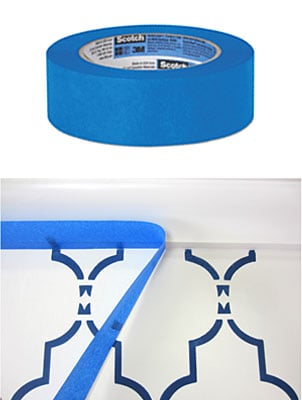 When stenciling, we usually use a low tack painters tape such as 3M blue tape to avoid pulling up any base coat paint. For walls, mask off the baseboards, moldings, ceilings and those surfaces that will not be stenciled Burnish (rub down) the edge of the tape for a cleaner line with less paint seepage. Always remove your masking tape slowly, pulling it an an angle.
When stenciling, we usually use a low tack painters tape such as 3M blue tape to avoid pulling up any base coat paint. For walls, mask off the baseboards, moldings, ceilings and those surfaces that will not be stenciled Burnish (rub down) the edge of the tape for a cleaner line with less paint seepage. Always remove your masking tape slowly, pulling it an an angle.A Few Words About Paints
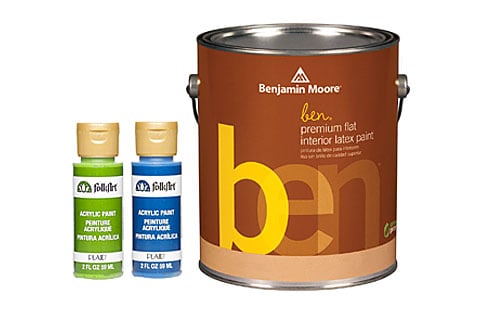 Primer
PrimerIf your walls are in need of repairs (cracks, holes, nail pops etc) first fill or spackle those areas, let them dry and then sand them smooth with fine (220) sand paper. Make sure you dust off the repairs before priming them. You can also wipe the repairs with a damp towel to remove any dust. Applying a Waterbased Drywall Primer to the repairs will help ensure good paint adhesion. Good paint adhesion is important because you will be taping the stencil to the wall and you want to prevent the tape from pulling off the base coat paint. Let the primer dry fully before applying.
Base paint
At Cutting Edge Stencils, we recommend base coating your walls with a flat sheen, water based paint using a tight nap roller for a smooth finish. Flat sheen paints accept the stenciling better then shinier paints. Flat sheen paint is porous, so it grabs your stencil paint before it has time to seep (bleed) under the edge of your stencil resulting in a crisper print. Flat paints are easier to touch up as well. Because they are not shiny, they tend to blend better without flashing. (Flashing is a term that describes a difference in sheen that occurs when trying to touch up higher sheen paints such as a semi-gloss.) So if you ever make a mistake stenciling your walls, it’s easy to paint over the mistake with a flat sheen paint and then re-stencil the area with great results.
Stencil Paint
For walls, we recommend a good quality Acrylic or Latex paint. Craft acrylics also work great. We also like Benjamin Moore “Ben” flat paint for stenciling walls. It gives a great result and is a good value. We don’t recommend using spray paint as it’s hard to control. Oil based paints are also not stencil-friendly. You can stencil with metallic paint, glaze or even plaster.
Using Spray Adhesive
Spray adhesive can give you crisper stenciled edges but it is not necessary to use it for stenciling. If a stencil is delicate, or has large cut outs, spray adhesive can help to hold the stencil in place and achieve better results. Select a repositionable adhesive (like Elmer’s) and spray the back of the stencil with an even coat. Do this in a well ventilated area and be careful about overspray. Let the adhesive dry for a few minutes so it doesn’t transfer to the project’s surface. Reapply spray adhesive as necessary during stencil project.
Choosing Your Colors
Look at some reference for color combinations that work well together and do a test sample so you are comfortable with your choices. Always take into consideration your givens, such as existing fabrics, floor or carpet colors. We love using white index cards for color swatches.
Sample Test
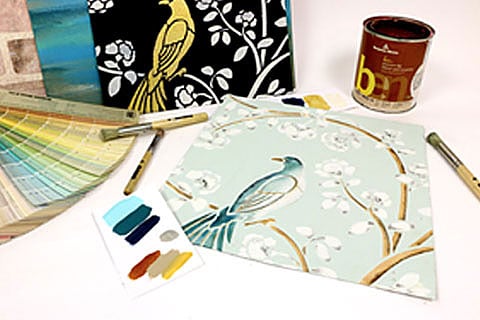 It is always a good idea to test your stenciling technique and color selections before starting your project. You can test your stencil and colors in a discreet place on your wall but it’s best to make a sample board. You can use a piece of cardboard, a pizza box, a piece of sheetrock or a piece of plywood for your sample. You’ll need to base coat the sample material in the same paint as your wall. Then you can do a few prints to get comfortable with your technique. You can also test the sample in different areas of the room to see how light might affect the color. And finally, you’ll have a sample that you can bring with you when shopping for fabrics and furniture to go with your beautifully stenciled walls!
It is always a good idea to test your stenciling technique and color selections before starting your project. You can test your stencil and colors in a discreet place on your wall but it’s best to make a sample board. You can use a piece of cardboard, a pizza box, a piece of sheetrock or a piece of plywood for your sample. You’ll need to base coat the sample material in the same paint as your wall. Then you can do a few prints to get comfortable with your technique. You can also test the sample in different areas of the room to see how light might affect the color. And finally, you’ll have a sample that you can bring with you when shopping for fabrics and furniture to go with your beautifully stenciled walls!Positioning Your Stencil
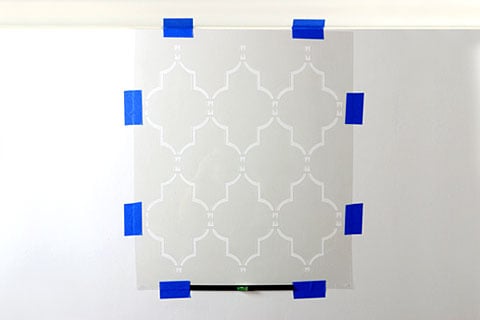 Start at the ceiling line in an area that will allow you to do a full column, from ceiling to floor without any windows or doors in the way. Use several pieces of low tack painters tape to secure the stencil. Don’t use regular white masking tape as it’s way too sticky and can pull off the base coat when you move your stencil. Don’t bend the stencil, trying to fit it into the ceiling crease. Simply tape it flat to the wall right next to the crown molding or ceiling line, which should be masked off with low-tack painters tape. Use our innovative Clip On Stencil Level to keep your stencil rows level. The level is so lightweight it can stay clipped to the stencil throughout your entire project. Once you’ve completed a full column, use the built in registration described below to start filling in left and right. For ceilings, the method is the same but we do recommend the use of spray adhesive in addition to the low tack painters tape to help hold the stencil in place.
Start at the ceiling line in an area that will allow you to do a full column, from ceiling to floor without any windows or doors in the way. Use several pieces of low tack painters tape to secure the stencil. Don’t use regular white masking tape as it’s way too sticky and can pull off the base coat when you move your stencil. Don’t bend the stencil, trying to fit it into the ceiling crease. Simply tape it flat to the wall right next to the crown molding or ceiling line, which should be masked off with low-tack painters tape. Use our innovative Clip On Stencil Level to keep your stencil rows level. The level is so lightweight it can stay clipped to the stencil throughout your entire project. Once you’ve completed a full column, use the built in registration described below to start filling in left and right. For ceilings, the method is the same but we do recommend the use of spray adhesive in addition to the low tack painters tape to help hold the stencil in place.Stenciling With a Dense Foam Roller
This is a super fast way to get the job done. Perfect for walls! Pour your stencil paint into a tray and EVENLY load your Dense foam roller. We don’t want a blotchy looking roller. Once your stencil roller is evenly saturated with paint, off load the excess paint by rolling it a couple times on folded paper towels. If the roller leaves stripy lines on the paper towels, reload the roller so it’s evenly coated and then off load it again on your folded paper towels. The roller should appear somewhat dry. Remember, It’s always better to have less paint on your roller because too much paint can cause paint seepage under the stencil.
Start rolling and slowly build up paint coverage using light to medium pressure. Don’t push too hard as this can cause paint bleed under the stencil. Carefully un-tape and pull back a corner of the stencil to see if your paint coverage is satisfactory. Reload and off load the roller as necessary.
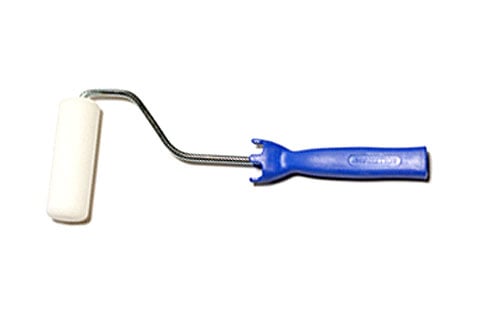
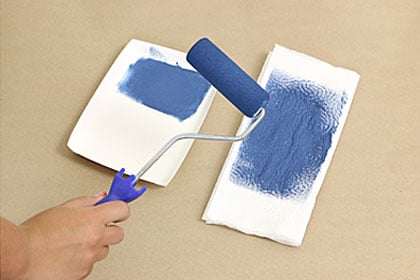
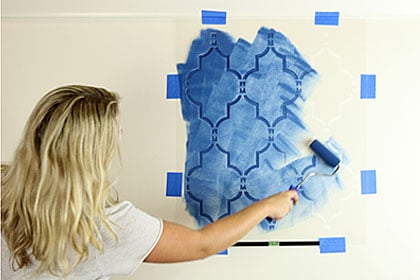
Start rolling and slowly build up paint coverage using light to medium pressure. Don’t push too hard as this can cause paint bleed under the stencil. Carefully un-tape and pull back a corner of the stencil to see if your paint coverage is satisfactory. Reload and off load the roller as necessary.



Repositioning the Stencil and Building a Pattern
All Cutting Edge Wall Stencils have a built in registration that makes alignment easy. This means that the stencil aligns with previously stenciled elements. This alighnment method is very easy to use and very Intuitive. An alignment diagram is shown in each stencil description on our website. Once you’ve completed a full column, use the built in registration described above to start filling in left and right. No need to wait for the previous print to dry: if you’re using flat paint this should not be an issue as the paint dries very quickly.
For ceilings, the method is the same but we do recommend the use of spray adhesive in addition to the low tack painters tape to help hold the stencil in place.
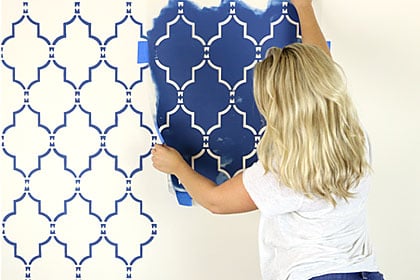
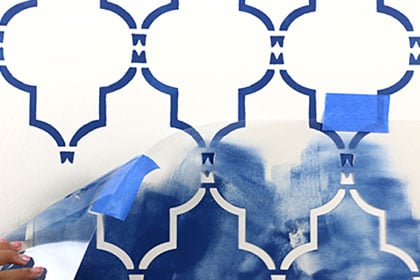
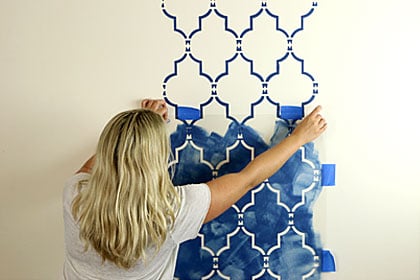
For ceilings, the method is the same but we do recommend the use of spray adhesive in addition to the low tack painters tape to help hold the stencil in place.



About Paint Bleed or Paint Seepage
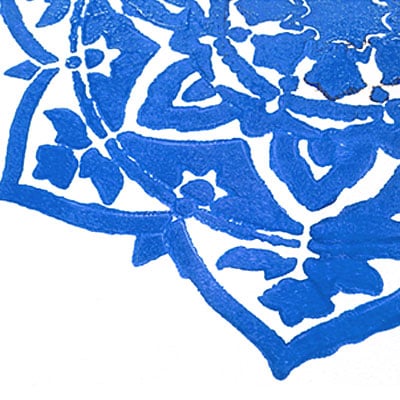 Stencil bleed occurs when paint seeps under the edge of the stencil leaving a less than perfect print. Don’t worry about this too much, but do take measures to reduce the amount of bleed. Know that there will always be some minor bleed here and there as we’re creating a hand-painted finish. But when the wall is done and you look at the entire project your eye will see the color and the pattern. In most cases you wouldn’t even notice a little bleed. But we still want to keep bleed to a minimum so we follow these guidelines:
Stencil bleed occurs when paint seeps under the edge of the stencil leaving a less than perfect print. Don’t worry about this too much, but do take measures to reduce the amount of bleed. Know that there will always be some minor bleed here and there as we’re creating a hand-painted finish. But when the wall is done and you look at the entire project your eye will see the color and the pattern. In most cases you wouldn’t even notice a little bleed. But we still want to keep bleed to a minimum so we follow these guidelines:Use a flat base coat paint. Use a flat stencil paint like “Ben”. Make sure the wall is smooth without a texture. Don’t overload your stencil roller and build the paint coverage up slowly, without pressing hard on the roller. Use spray adhesive for even crisper edges. Minor mistakes and bleed can be wiped off with baby wipes or moist rag while the mistake is still fresh. Alternatively, the mistakes can be touched up later with a small brush.
Stenciling Ceiling Edge And Around Moldings
When all walls are done, it’s time to fill in the gaps in the pattern left at the ceiling line. This is done using a Top Edge stencil designed just for that. You can finish the pattern with your large stencil too, but it's much easier and less cumbersome with our Top Edge stencil, which is included with those wall stencils that need it.
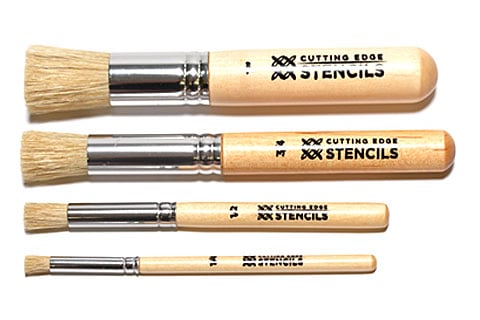
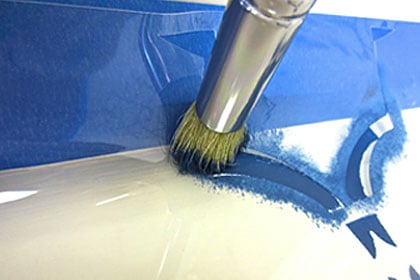
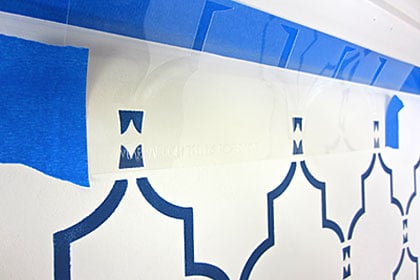



For baseboards, window and door moldings simply mask off the moldings and bend the stencil into the crease, using pieces of tape to help secure it if necessary. Roll right into the crease and then use a Stencil brush to detail the edge. In general, select your stencil brush size based on the size of the stencil openings. The smaller the openings - the smaller the brush. For edges and corners a regular size stencil brush (1/2” or 5/8”) works well.
To load the stencil brush with paint: dip just the brush tip into the paint (only about 1/8”) and then swirl it on the tray to evenly distribute the paint into the bristle tips. Off-load the excess paint onto some folded paper towels. Like the roller, the brush should appear almost dry. Pouncing (straight up and down motion) works great for filling in areas with color. You can stencil your walls using stencil brushes, but it’s clearly much more time consuming than stenciling a wall with a roller. Select the largest stencil brush if you want to go this route.
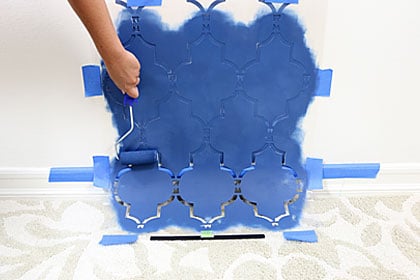
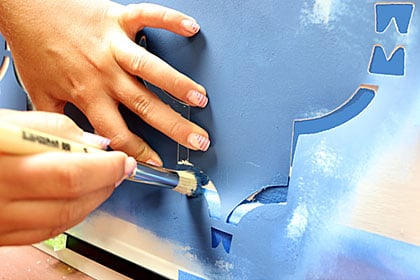
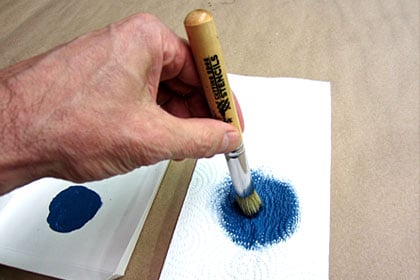
To load the stencil brush with paint: dip just the brush tip into the paint (only about 1/8”) and then swirl it on the tray to evenly distribute the paint into the bristle tips. Off-load the excess paint onto some folded paper towels. Like the roller, the brush should appear almost dry. Pouncing (straight up and down motion) works great for filling in areas with color. You can stencil your walls using stencil brushes, but it’s clearly much more time consuming than stenciling a wall with a roller. Select the largest stencil brush if you want to go this route.



Stenciling Corners
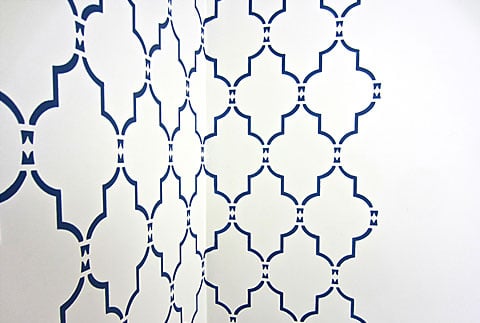 This is achieved by masking off the opposite wall, and bending the stencil into the corner. Secure the stencil with tape only on the side of the wall that you are stenciling, and roll right into the corner. Then use a stencil brush to get deep into the corner crease to fill in all the openings. Once you have completed the first wall all the way down, tape off the wall you have just completed. Then, starting at the top, align the stencil with your completed wall, secure the part of the stencil on the unpainted wall with tape leaving the other half loose, and continue stenciling on the next wall.
This is achieved by masking off the opposite wall, and bending the stencil into the corner. Secure the stencil with tape only on the side of the wall that you are stenciling, and roll right into the corner. Then use a stencil brush to get deep into the corner crease to fill in all the openings. Once you have completed the first wall all the way down, tape off the wall you have just completed. Then, starting at the top, align the stencil with your completed wall, secure the part of the stencil on the unpainted wall with tape leaving the other half loose, and continue stenciling on the next wall.
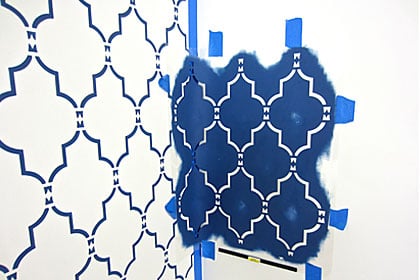
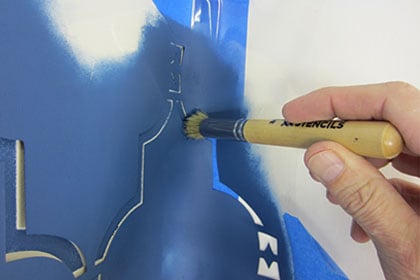
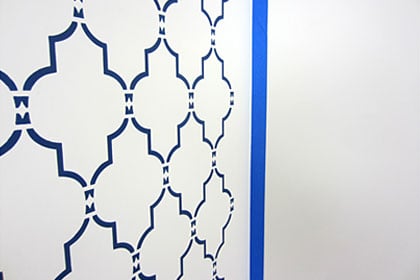
Clean Up
If you clean your brushes, rollers and stencils as soon as you are done with your project, the paint comes off much easier. Don’t soak your stencil brushes for a long time: the natural bristles expand and may split the metal ferrule. Using a drop of brush cleaner or Murphy’s Oil Soap works well for cleaning brushes. Using a Brush scrubbing tool helps to better remove paint particles from the brush bristles. Don’t let your brushes or roller dry out during the project. If you take a break, put them in a plastic baggie or cover with damp cloth.
Your stencil does not have to be cleaned after each repeat. It’s time to clean the stencil when there is a noticeable accumulation of paint - usually after quite a few repeats. In our experience, 10-15 repeats or more. Often you’d be able to stencil an entire medium size accent wall without cleaning the stencil. To clean your stencil, lay it on a flat surface such as a cutting board or a cookie tray, spray it with water and gently scrub with a dish brush under running water. Make sure you have a sink strainer in place to catch any paint pieces. If the paint on the stencil is very dry – we call it "caked" – let is soak for a while before scrubbing it. Lay the cleaned stencil onto paper towels and pat or roll it dry with a roll of paper towels – works great!
It’s not easy to remove spray adhesive from the stencil, but we find that the product called Signature Thread Spray It DK5 Glue Remover works really well. Our stencils are very durable and with proper care and cleaning should last for years!
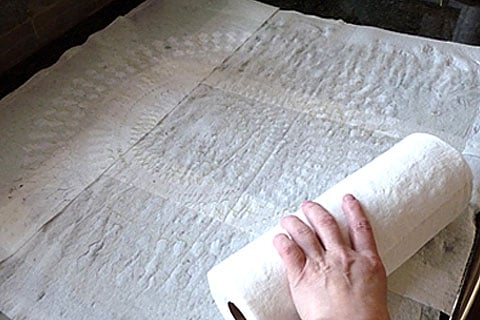
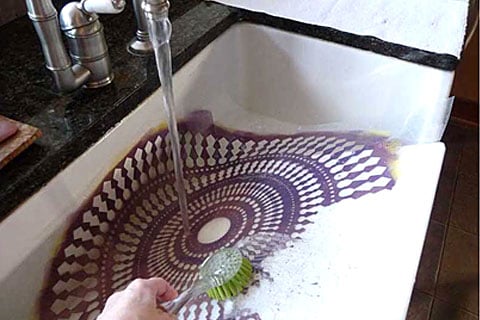
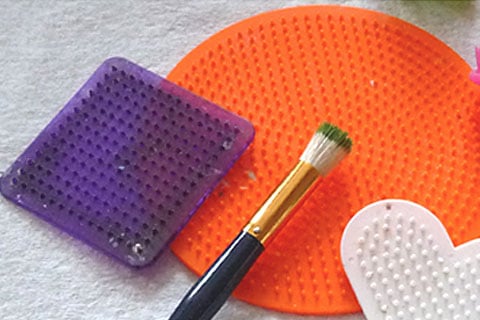
Your stencil does not have to be cleaned after each repeat. It’s time to clean the stencil when there is a noticeable accumulation of paint - usually after quite a few repeats. In our experience, 10-15 repeats or more. Often you’d be able to stencil an entire medium size accent wall without cleaning the stencil. To clean your stencil, lay it on a flat surface such as a cutting board or a cookie tray, spray it with water and gently scrub with a dish brush under running water. Make sure you have a sink strainer in place to catch any paint pieces. If the paint on the stencil is very dry – we call it "caked" – let is soak for a while before scrubbing it. Lay the cleaned stencil onto paper towels and pat or roll it dry with a roll of paper towels – works great!
It’s not easy to remove spray adhesive from the stencil, but we find that the product called Signature Thread Spray It DK5 Glue Remover works really well. Our stencils are very durable and with proper care and cleaning should last for years!



Stencil Storage
It’s best to store your stencil flat whenever possible. We recommend placing your clean stencils between 2 pieces of paper or cardboard and storing them under the bed or even under an area rug!
Are you ready to stencil?
Stenciling is such an amazing and easy technique that opens the doors to endless decorative possibilities! Don’t be intimidated - be inspired! Just follow these guidelines, and in no time you’ll be stenciling like a pro! Want to learn more about stenciling? Check out our Blog or watch our informative and inspiring How To Stencil Videos! 